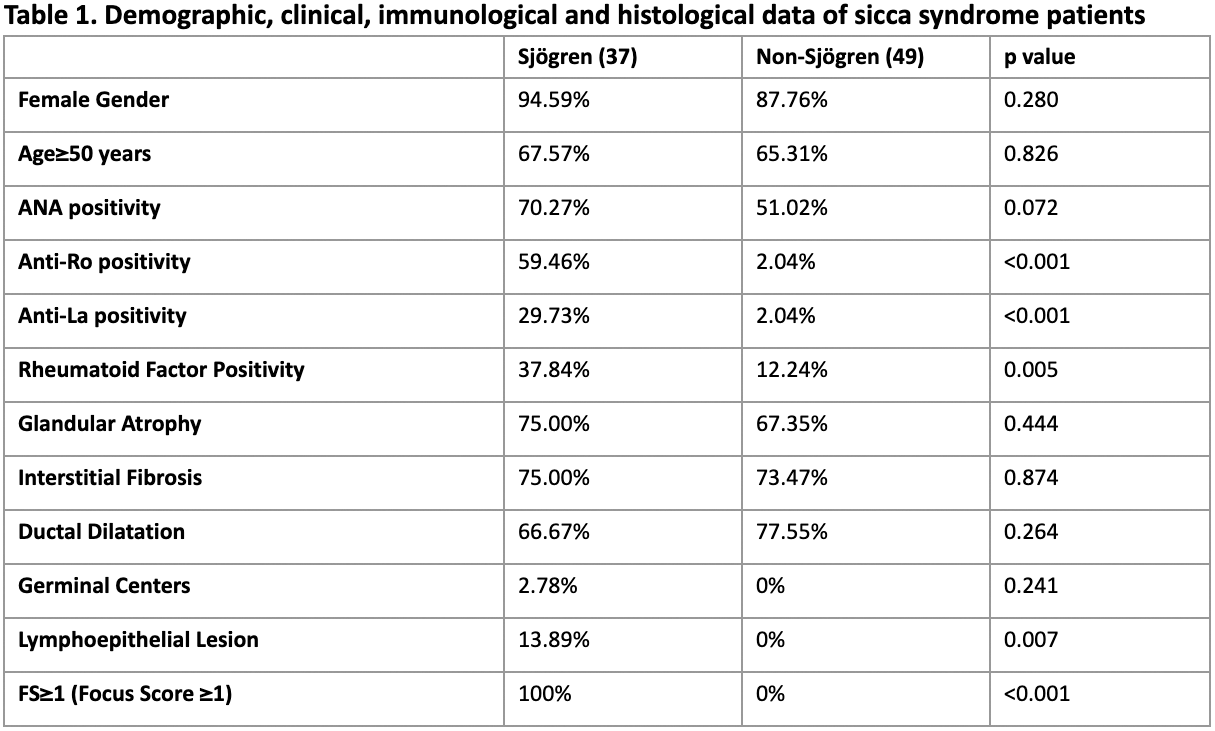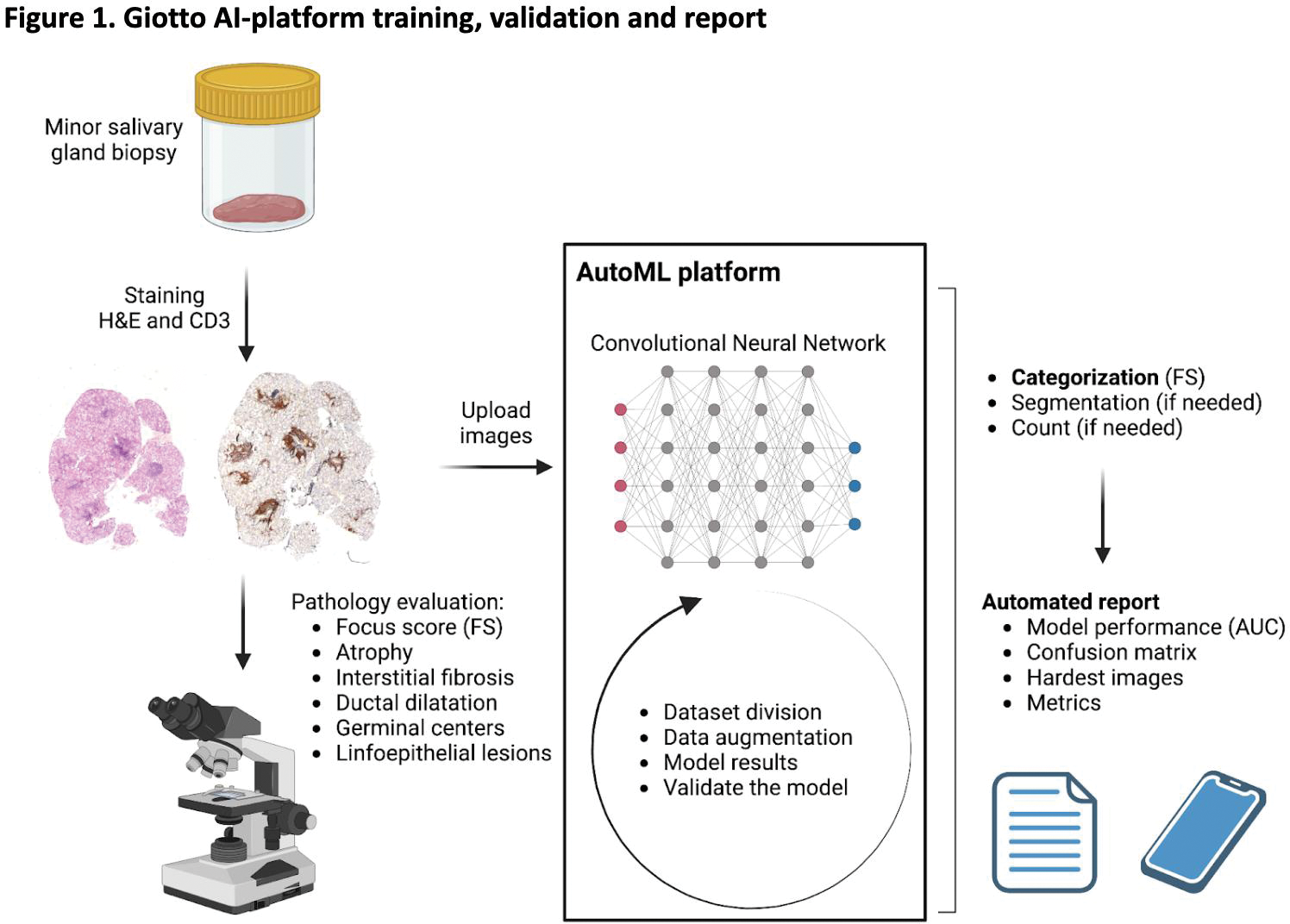

Background: The histopathological analysis of minor salivary gland biopsies, particularly through the quantification of the Focus Score (FS), is pivotal in the diagnostic workflow for Sjögren’s Syndrome (SS). AI-based image recognition by deep learning models has shown promise in enhancing diagnostic workflows and preclinical research. This study explores the utility of an auto-machine learning (autoML) platform for automated delineation and quantification of FS on histopathological slides to improve diagnostic precision and speed in SS.
Objectives: To leverage an autoML platform for the automated analysis of salivary gland biopsies in SS, aiming to augment diagnostic accuracy and efficiency.
Methods: A cohort of 307 patients with sicca syndrome was evaluated, with a subset of 86 patients selected for in-depth histological examination. A repository of 172 slides was assembled, classified into SS (FS ≥1) and non-SS. The Giotto autoML platform, using a Convolutional Neural Network (CNN), was employed for training and validation using this dataset. A compilation of 172 images (2 per patient, H&E and CD3) was created, which included 74 images indicative of SS and 98 images representing normal salivary glands. The images were subsequently partitioned into training (138 images, 80%) and validation datasets (34 images, 20%) for further analysis.
Results: Table 1 presents demographic, clinical, immunological, and histological data between the SS and non-SS groups. Notable differences were observed in Anti-Ro positivity, Anti-La positivity, Rheumatoid Factor positivity and FS ≥1 between the two groups.
The algorithm with information on training and validation of the datasets is shown in Figure 1. Following an automated image preprocessing procedure augmented with data, a CNN architecture based on the ResNet-101 model was employed (size of 178.43 MB, 10 epochs). The training dataset comprised 138 images (83 Non-SS, 55 SS), while the validation dataset comprised 34 images (15 Non-SS, 19 SS).
In the conducted evaluation, the diagnostic model demonstrated a sensitivity of 89.47% (95% Confidence Interval [CI]: 66.86% to 98.70%) and a specificity of 88.24% (95% CI: 63.56% to 98.54%). The Positive Likelihood Ratio (LR) was observed to be 7.61 (95% CI: 2.05 to 28.21), while the Negative LR was ascertained at 0.12 (95% CI: 0.03 to 0.45). The Positive Predictive Value was 3.68% (95% CI: 1.02% to 12.42%), whereas the Negative Predictive Value was notably high, at 99.94% (95% CI: 99.78% to 99.98%). The overall accuracy of the model was delineated at 88.24% (95% CI: 73.13% to 96.54%).
Conclusion: AutoML or no-coding platforms provide agility to furnish clinicians with a swift and flexible means for prototyping machine learning models, even with smaller datasets, as exemplified in this study for SS. ML algorithms have the potential to significantly enhance the precision and efficiency of both clinical and scientific workflows. Multicentric investigations involving a more extensive patient cohort are imperative for a comprehensive evaluation and validation of this innovative diagnostic modality.
REFERENCES: [1] Yao K, Singh A, Sridhar K, Blau JL, Ohgami RS. Artificial Intelligence in Pathology: A Simple and Practical Guide. Advances in Anatomic Pathology. 2020;27(6):385-393.
[2] Wicheta S, Van der Groen T, Faquin WC, August M. Discrepancies in Interpretation of the Minor Salivary Gland Biopsy in the Diagnosis of Sjögren Syndrome. Journal of Oral and Maxillofacial Surgery. 2019;77(8):1628-1635.


Acknowledgements: NIL.
Disclosure of Interests: None declared.